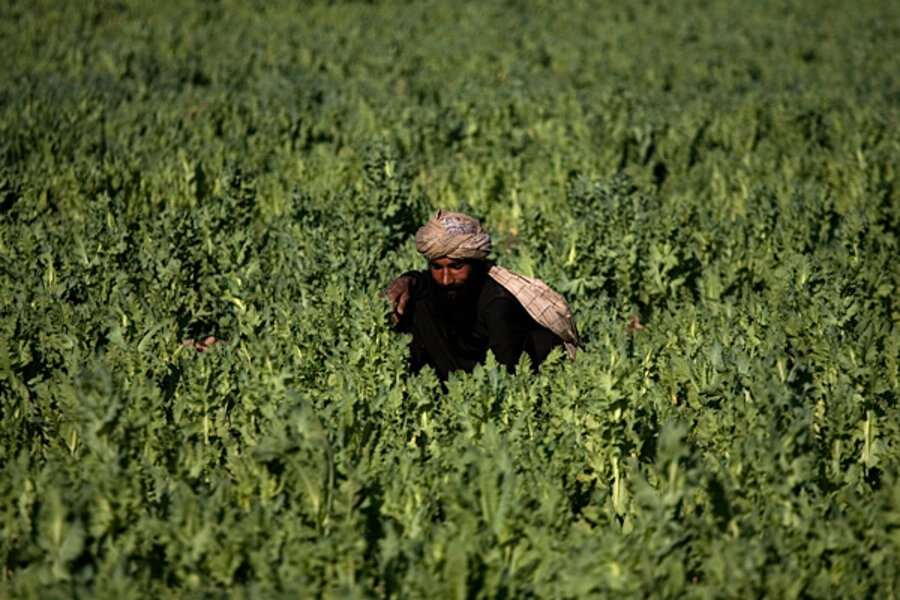Why some Afghanistan opium farmers turn from poppies to saffron
Loading...
| Herat, Afghanistan
Eight years after getting out of the poppy business, Hajji Ibrahim says he doesn’t miss it. The farmer here in western Afghanistan used to employ 10 guards to protect his land from roving addicts and warlords. Harvesting the poppies was so strenuous that, though women often help with such work, he says those in his family could not help. Still, it was difficult to find a crop that produced returns like poppies.
After the fall of the Taliban forced him to find other options, however, he planted a small, 300- square-meter (3/4 of acre) patch of saffron. It was easy to cultivate, so women could tend to it, and it was 20 percent more profitable than poppies.
“As I balanced all the pros and cons of growing saffron or poppies, there were many benefits for saffron – mostly, it is not against Islamic law,” says Mr. Ibrahim, who now devotes a sizable 30,000 square meters (7.4 acres) of his land to saffron.
With at least 80 percent of Afghanistan’s workforce involved in agriculture, policymakers have long focused on rehabilitating the farming sector to provide profitable options other than poppies, which fuel the country’s opium trade. The United States has touted wheat as an alternative crop, but with a market price three times lower than opium, few farmers care to make the switch.
Saffron sells high on the international market and can be grown on otherwise unused fields. But it is nowhere near the perfect substitute for opium – farmers have struggled to effectively process and market saffron well enough to be competitive in the international market.
As a result, Ibrahim says that before more of his neighbors devote their fields to saffron, they will have to see that it is a reliable source of income. That will not happen without better processing facilities.
$2,000 per kilogram
In Herat, where a dry climate makes it one of the best saffron-growing regions in Afghanistan, currently 300 hectares of farmland are devoted to the purple flower – a number that should grow by about 100 hectares per year, according to the United States Department of Agriculture. Though that’s less than one percent of the region’s active agricultural land, US officials say saffron is one of the three most important crops in the province, the others being wheat and grapes.
The plant is the most expensive spice in the world by weight and can sell for $2,000 to $3,000 per kilogram, whereas most of the food grown in the region is consumed by farmers or sold at local markets for a modest profit.
Saffron has the potential to generate $100 million of income a year for Herat alone if the region can devote 5,000 to 7,000 hectares of farmland to the flower, says M. Hashim Astami, an independent saffron and natural resource expert in Herat.
Saffron also grows on land that is traditionally too dry for other crops, so it would not replace anything currently being cultivated in the region or reduce food production. On top of that, the growing season is in October and November when other plants do not need water, so canals are full and there is ample water to irrigate the saffron fields.
This year, the US will contribute by supplying farmers with 50 tons of saffron seeds to increase the reach of the crop.
Searching for buyers
Still, Mr. Astami worries that farmers are producing saffron faster than companies can be established to process and market it.
“Saffron production, processing, and marketing should grow together,” he says. “But production has increased very fast, processing has increased very slow, and marketing is very weak.”
In the 1990s in Peru, US efforts to encourage farmers to stop producing coca leaves (for the illegal cocaine market) and replace them with cocoa beans (for chocolate) initially failed because coca farmers were taught only how to grow alternative crops, but did little connect them with the niche markets that brought the best prices. That crop replacement program in Peru has since become successful.
Without proper processing, saffron loses its distinctive coloring and taste. Harmful bacteria can also take root in the plant. Consequently, a poorly rendered batch of the crop sells at about 40 percent below market rates – if at all.
Few people inside Afghanistan use saffron, so if farmers cannot produce a product that is viable in the international marketplace, they may not be able to sell it at all. Last year, a number of farmers experienced this problem, which dealt a blow to the appeal of growing saffron, says Sayed Wahidullah Aqil, the provincial management adviser for the US Department of Agriculture in Herat.
“Farmers in Afghanistan get their information from their neighbors. If there is a farmer who is cultivating saffron and this year he cannot sell his product, his neighbors will see this and this may decrease their interest in saffron,” he says.
Aside from increasing the quality of saffron, companies must also work to make Afghan saffron more attractive on the international market, which is dominated by Iran.
This has been a focus for people like Basher Ahmad Rashidi, something of a saffron evangelist and project manger at Afghan Saffron, which was established in 2006 and claims to be Afghanistan’s first specialized saffron company.
By training its farmers how to properly process saffron, the company has managed to produce a high-quality product and build a client base in Spain, France, the United Arab Emirates, India, USA, and it is just starting to make headway in the Japanese market.
If farmers and companies can effectively partner, Mr. Rashidi says that saffron has the potential to become a powerful tool for his country’s development.
“It is all linked together,” he says. “When the farmer has good opportunity to generate income then all of Afghanistan has a good chance to grow.”
RELATED STORIES:





